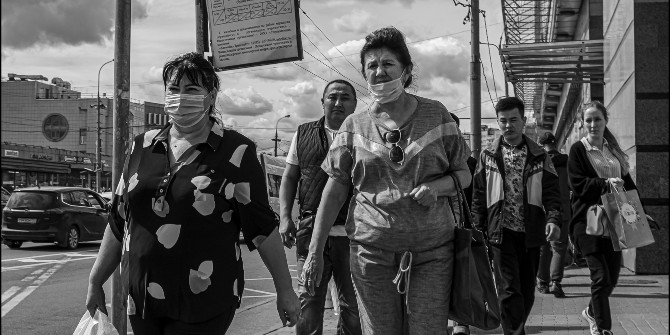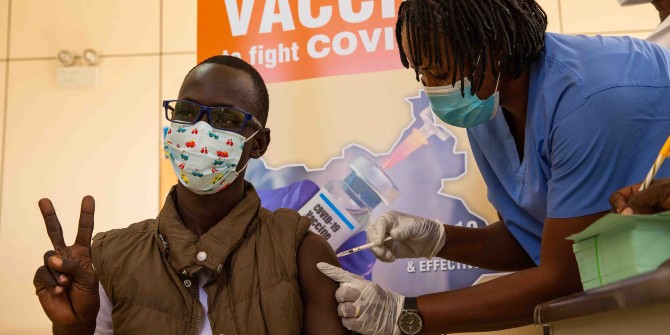Women in Eurasia have suffered disproportionately from the effects of COVID-19 lockdowns, losing their jobs more often than men and taking on a greater domestic burden. But the policies their governments are adopting have utterly failed to address this, says Karena Avedissian (American University of Armenia).
As in all crises, women and girls have been disproportionately affected by COVID-19, and Eurasia is no exception. Unfortunately, the immediate policy responses of Armenia, Georgia, Kazakhstan, Kyrgyzstan, and the Russian Federation – with one exception – have not adequately addressed their needs and concerns.

These policy responses have reinforced pre-existing inequalities, and may serve to reverse the modest gender equality gains made recently, such as reduced inequalities in traditional gender roles, and access to employment. As such, Eurasian states are missing an opportunity to leave no one behind – a key concept of the UN’s Sustainable Development Goals, potentially delaying recovery and making women vulnerable to long-term damage to their livelihoods.
Women are more likely to lose their jobs and incomes
Past experience shows that when jobs are threatened, women are denied labour opportunities more often than men. Sectoral segregation in Eurasia, as elsewhere globally, also means feminised industries have been hardest hit by the pandemic. In Russia, unemployment among women jumped from 5.4 percent in April 2020 to 6.1 percent in May, while for men it actually decreased from 6.1 percent to 6 percent during the same period. The number of Russian women who lost their homes because they could not pay the rent after losing their jobs rose 40 percent in March 2020.
Most employed women in Eurasia work in the informal economy, with little or no social protection. They make up the bulk of unpaid workers in farming or family businesses, as well as market and street sellers. These jobs often depend on socially close interactions in public, which are now restricted to limit the spread of the pandemic. In Kyrgyzstan, for example, people working in these roles experienced a 60% decline in earnings in the first month of the pandemic alone.
More domestic responsibilities
The world’s formal economies and the daily functioning of families, communities, and the formal economy are built on the foundation of the invisible and unpaid labour of women and girls.
In Kyrgyzstan and Kazakhstan, reports show that the burden of unpaid care and domestic work has increased for women in particular since the start of the pandemic. In a survey about how Georgian men and women were spending their time during stay-at-home orders, women reported that were engaging in (in descending order of frequency): cooking, housekeeping, management of household chores, childcare, and home schooling. In contrast, men dealt with management of household chores, shopping, leisure, pet care, and playing with children.
Gender-based violence
Stay-at-home orders of varying degrees of stringency were based on the assumption that home is the safest place to be during a pandemic. This does not hold true for the many women and girls living with abusive partners and family members. UN Secretary General António Guterres has called for steps to address a global upsurge in domestic violence against women and girls connected to lockdowns.
Even before the pandemic, the number of women in Eurasia subjected to intimate partner violence was high. Emerging data show that since the introduction of lockdowns, reports of violence against women have increased. In Kazakhstan, for example, the number of women contacting women’s rights defenders since stay-at-home orders were issued has increased from 10-15 calls per day to 25. In Armenia, they have increased by 30 percent. In Russia, where domestic violence was decriminalised in 2017 and where thousands of women are killed by their husbands every year, the volume of calls to a national domestic violence hotline rose 24 percent in March 2020 compared to February. Combined with the gaps in legislation, inadequate police and legal responses leave women with little or no protection or access to justice.
Policy responses are crafted with men in mind
The threat COVID-19 poses to healthcare systems is existential, and prompt policy responses to boost the healthcare sector are clearly prudent. However, none of the healthcare policy responses in Eurasia are based on any systematic mapping of women’s needs, even as women comprise the backbone of the region’s healthcare systems.
Governments in the region have been quick to adopt macroeconomic policies to support the private sector, given collapsing state revenues. However, none of these supports gender-equitable growth, or more and better jobs for women. If women are losing employment at higher rates than men, policies that aim to preserve jobs should de facto preserve jobs for women. Furthermore, no Eurasian country has addressed occupational and sectoral segregation, or established mechanisms for women to re-enter the job market.
Social protection schemes for workers and households include unemployment benefits as well as emergency cash transfers for vulnerable groups. None of them address the structural socio-economic inequities that women face. Only one short-term policy response specifically targets women – an Armenian measure providing lump sum cash benefits for pregnant women, married and unmarried. None provide any provision for care or support for survivors of gendered violence.
A missed opportunity
Eurasian countries are missing an opportunity to address structural gendered inequalities for long-term recovery, and are prioritising short-term revenue instead. Other options are available. Multilateral organisations can, for example, support governments to address liquidity problems and allow them to focus on long-term, sustainable reforms. By supporting women specifically, Eurasian governments could make long-term and sustainable changes to their healthcare, private sector, and socio-economic situation.
The response to the current crisis needs to accommodate, not sideline, social dialogue and democratic engagement and ensure that gender equality gains are not reversed. Of course, ideas of what recovery requires differ. Policy is enacted through pre-existing power structures, and those who are typically excluded face more obstacles in seeing their vision of recovery happen. It is crucial to understand how seemingly benign interventions can reinforce exclusionary practices.
This post represents the views of the author and not those of the COVID-19 blog, nor LSE.






1 Comments